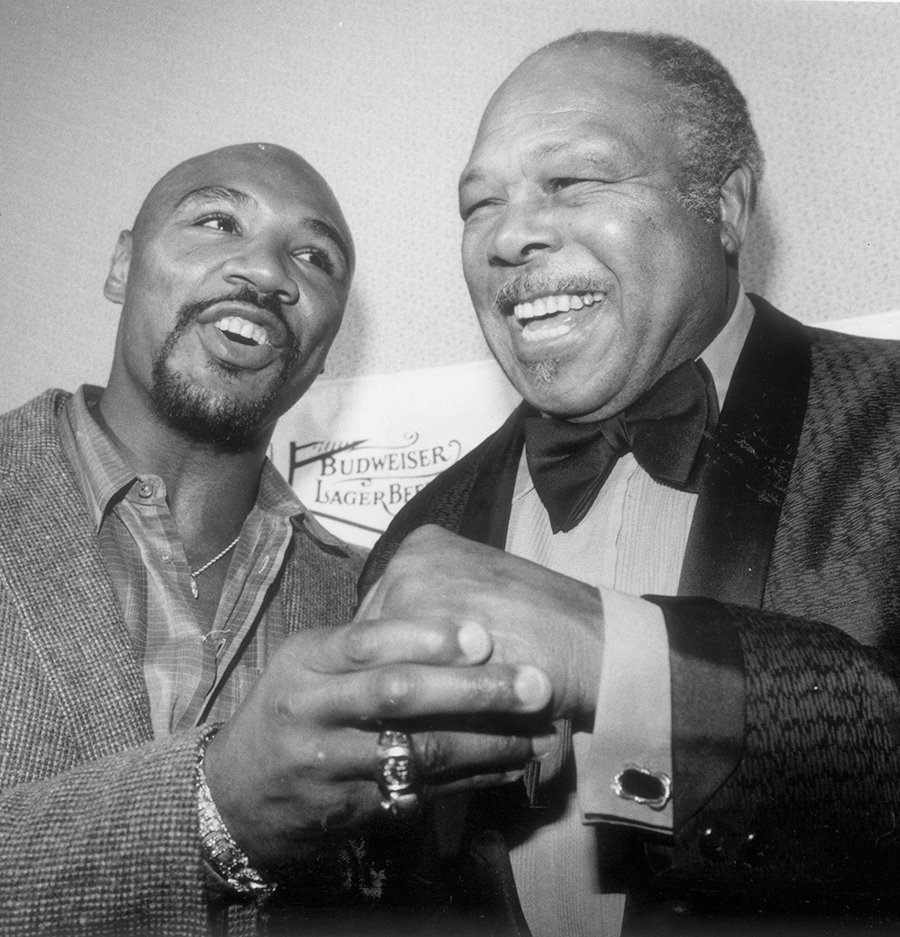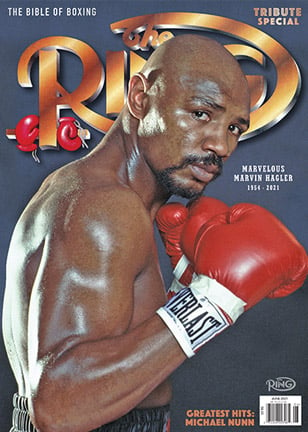
HAGLER, A CONSUMMATE PROFESSIONAL WHO EMBODIED THE VIRTUES OF BOXING DESPITE THE SHADY SIDE OF THE SPORT, REMAINED LOYAL TO HIS FRIENDS DURING HIS HARD ROAD TO GREATNESS
On the afternoon of March 13, 2021, boxing fans who grew up during the 1980s lost a little bit of their childhood as news spread that the great Marvelous Marvin Hagler had unexpectedly passed away in New Hampshire at the age of 66.
Boxing lost more than one of its all-time greats; it lost the best representation of a time when the fight game was more important to the American sports landscape.
Alongside the trio of Sugar Ray Leonard, Thomas Hearns and Robert Duran, the Four Kings carried the boxing business after the retirement of Muhammad Ali and bridged the gap until Mike Tyson began his malevolent rule as the undisputed heavyweight champion.
Hagler’s personality and style weren’t as dynamic as his peers, but he symbolized what a boxer should be and how they should conduct themselves. While perhaps the least-known of this storied foursome going into the ’80s, he eventually became a fan favorite and an iconic figure in his own right.
Hagler was responsible for helping create a generation of boxing fans that has carried on into the 21st century. He was the rare fighter universally beloved and respected, whose stature grew in retirement as he steadfastly refused to return to the ring after walking away. That alone makes him noteworthy and admirable.
“A true professional prizefighter, and a champion,” is how longtime HBO analyst Larry Merchant described him. “A professional in a sense that he could box, he could bang, he could take a shot. When you paid to see him perform, you got what you paid for.”
But while Hagler always delivered in the ring, it would take a long time for the sport to deliver for him. His road to the title was long and hard. From his humble pro debut at the Brockton High School Gymnasium on May 18, 1973, where he stopped Terry Ryan in two rounds, until his years as an avoided contender, Hagler would find himself on the outside looking in as it related to the byzantine world of boxing.

Real recognized real: Hagler meets up with former light heavyweight king Archie Moore at a press conference in 1984. (Photo by John Tlumacki/The Boston Globe via Getty Images)
Career advancement in boxing oftentimes is not based on meritocracy but rather shady dealings and unholy unions. Still, Hagler wanted to earn his status in the sport. At his insistence, Goody and Pat Petronelli (who trained and managed him throughout his career) took him into Philadelphia, where he could test himself against the best middleweights that storied boxing city had to offer.
From 1976 to 1980, he engaged in a series of bouts versus the likes of Bobby “Boogaloo” Watts, Willie “The Worm” Monroe, Eugene “Cyclone” Hart and “Bad” Bennie Briscoe, making regular visits to the Spectrum and compiling a record of 5-2 against that quartet while forging himself into the No. 1 middleweight contender in the world.
The only problem was that he was effectively being blackballed by the powers that be, which is why Massachusetts Senator Ted Kennedy and Speaker of the House Tip O’Neill wrote a letter strongly “suggesting” to Bob Arum that he do his part to help facilitate the hard-earned title shot for their constituent.
Arum said that being a staunch Democrat, he was honored that they would reach out to him, but he also admitted he was “scared to death,” as he didn’t want to be known as that generation’s Frankie Carbo. So, starting with Hagler’s bout with Norberto Cabrera (an eighth-round stoppage victory) in Monaco in the summer of 1979 until the end of his career in 1987, Arum was Hagler’s promoter.

Bob Arum (left of podium) worked with Hagler for over eight years and spearheaded his final fight against Sugar Ray Leonard. (Photo by The Ring Magazine via Getty Images)
Hagler eventually won the middleweight crown in 1980 by bludgeoning Alan Minter in England (then quickly leaving the ring and a rioting Wembley Arena amid a hailstorm of bottles that came from all sections).
The Hagler-Arum union lasted 19 bouts as the switch-hitting middleweight went from a relatively unknown champion to a nationally known sports celebrity who scored endorsement deals with Right Guard and Pizza Hut, sat on the couch as a guest of Johnny Carson on The Tonight Show and paid a visit to the White House and Ronald Reagan. And while he was originally from Newark, New Jersey, he was more than embraced by his adopted hometown of Brockton, Massachusetts, and the New England region.

Hagler, here at Logan International Airport in September 1980, was a popular figure in Boston. (Photo by Janet Knott/The Boston Globe via Getty Images)
“There were two big sports stories in Boston at the time – it was Marvelous Marvin Hagler and the Boston Celtics,” said Arum, who recalled that the local network affiliates in the region would battle for access to the local favorite during his middleweight title reign.
Through it all, Hagler insisted that the Petronellis take their 33 percent, even as his paydays increased, and his contract with the storied promoter was nothing more than a handshake.
“The thing about Marvin that differentiates himself from most people that I met in life, certainly most people I’ve represented, is that he had unquestionable loyalty to those he dealt with. He dealt from a standpoint of ‘You’re with me and I’m with you. I’ll have your back and you’ll have mine,’” stated Arum, who thinks so highly of Hagler that the former middleweight champ is one of three boxers he has framed pictures of in his office (the other two being Muhammad Ali and George Foreman).
“That is really refreshing for me, something that is not usual in our society. He had a quality about him that almost epitomized the way he fought.”
With his shaven skull and sculpted body, Hagler cut an imposing and intimidating figure. In many ways, he just looked like a modern-day gladiator. But this intimidating exterior hid a man of deep character who cared about others.
Ray Mancini, who read about Hagler’s Philadelphia exploits in the pages of Ring Magazine as a teenage up-and-comer in Youngstown, Ohio, says that Hagler and Larry Holmes were the only two friends he had during his days as a hard-hitting matinee idol.
Mancini vividly recalls the night he lost his WBA lightweight title at the Memorial Auditorium in Buffalo, New York, in 1984. After being stopped in the 14th round by Livingstone Bramble, “Boom Boom” was dazed and disoriented.
Both of his parents were in attendance and, Mancini recalls, “Marvin grabbed both and cleared the way for them to come up and see me. He stood up on the steps as they got into the ring to make sure I was OK. I loved him forever for that; I just appreciated him doing that. People don’t understand, that’s the type of guy he was.
“He was a beautiful person.”
It turns out that Hagler was just as good out of the ring as he was in it.
“He was a wonderful, wonderful human being,” said Arum. “You always knew where you stood with him.”


